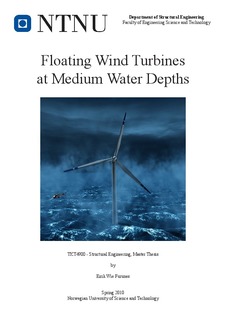| dc.contributor.author | Furunes, Eirik Wie | nb_NO |
| dc.date.accessioned | 2014-12-19T11:58:44Z | |
| dc.date.available | 2014-12-19T11:58:44Z | |
| dc.date.created | 2010-12-07 | nb_NO |
| dc.date.issued | 2010 | nb_NO |
| dc.identifier | 375138 | nb_NO |
| dc.identifier.uri | http://hdl.handle.net/11250/236604 | |
| dc.description.abstract | Offshore wind turbines have an enormous potential in terms of larger average wind speeds and low surface roughness compared to their onshore counterpart. Shallow water fixed wind turbines are ranked as a mature technology but are also limited by the price tag of creating and installing fixed installations for increasing depths. Hywind, which is a floating wind turbine concept developed by Statoil with focus on larger depths but may prove beneficial for shallower depths and fill the present void between floating and fixed wind turbines.
Hywind is limited for shallower waters by among others its large draft and the thesis focus is on a reduction of the draft with the inclusion of a heave plate for possible increased performance. The performance in ultimate limit state (ULS) and fatigue limit state (FLS) are utilized as a base for comparisons between different draft configurations.
Non-linear time domain analyses are carried out in FLS and ULS by the coupled computer codes SIMO/RIFLEX including wind, wave and current loads. In the non-linear analyses performed the hydrodynamic loads are calculated at the actual displaced position of the structure and instability effects as the Mathieu instability are accounted for, and also investigated in combination with a second order heave force contribution.
The analysis procedures and theory for floating offshore wind turbines are investigated and analysis parameters are defined in terms of ULS and FLS load cases, natural frequencies, a simplified wind turbine control system, damping estimates and heave plate properties.
In FLS the draft length has proven as an integral parameter and reduction in lifetime is shown for reduced draft configurations. The inclusion of a heave plate is shown to give an increase in lifetime, although minimal. In ULS peak values are increased for the reduced draft configurations and inclusion of the heave plate has shown to reduce dynamic heave motion but increase dynamic pitch motion. | nb_NO |
| dc.language | eng | nb_NO |
| dc.publisher | Norges teknisk-naturvitenskapelige universitet, Fakultet for ingeniørvitenskap og teknologi, Institutt for konstruksjonsteknikk | nb_NO |
| dc.title | Floating wind turbines at medium water depths | nb_NO |
| dc.title.alternative | Flytende offshore vindmøller på moderate vanndyp | nb_NO |
| dc.type | Master thesis | nb_NO |
| dc.contributor.department | Norges teknisk-naturvitenskapelige universitet, Fakultet for ingeniørvitenskap og teknologi, Institutt for konstruksjonsteknikk | nb_NO |
